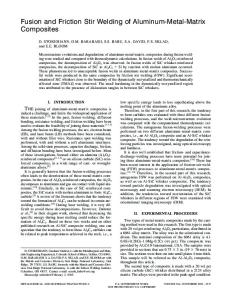Fabrication of Aluminum Foam/Dense Steel Composite by Friction Stir Welding
- PDF / 347,676 Bytes
- 3 Pages / 593.972 x 792 pts Page_size
- 62 Downloads / 347 Views
Composites fabricated from aluminum foam and a dense metal are expected to reduce the weight and increase the stiffness of automotive components. Examples of these composites include sandwich panels consisting of metallic sheets with an aluminum foam core[1–5] and metallic tubes with an aluminum foam filling.[1,3,6] In these composite structures, adhesives ordinarily are used for bonding between the aluminum foam and the dense metal. However, adhesives have raised considerable environmental concerns,[7] are difficult to recycle,[5] and cannot be used in heat-resistant nonflammable components.[5] Therefore, in the fabrication of sandwich panels, it is desirable that a foamable aluminum alloy sheet containing a blowing agent called the ‘‘precursor’’ and dense metallic sheets are bonded by a mechanical process such as extrusion or rolling without using adhesives, after which the precursor is expanded by heat treatment to induce foaming.[5,8] Recently, a new processing route for fabricating aluminum foam, which uses friction stir welding (FSW), has been developed.[9,10] In this method, an
YOSHIHIKO HANGAI, Associate Professor, and SHINJI KOYAMA, Assistant Professor, are with the Department of Mechanical System Engineering, Gunma University, Kiryuu 376-8515, Japan. Contact e-mail: [email protected] MAKOTO HASEGAWA, Research Associate, is with the Division of Materials Science and Engineering, Graduate School of Engineering, Yokohama National University, Yokohama 240-8501, Japan. TAKAO UTSUNOMIYA, Professor, is with the Research Organization for Advanced Engineering, Shibaura Institute of Technology, Saitama 337-8570, Japan. Manuscript submitted April 23, 2010. Article published online June 29, 2010 2184—VOLUME 41A, SEPTEMBER 2010
aluminum alloy and a blowing agent powder are mixed by FSW to fabricate the precursor. FSW[11] primarily was developed to join metals and alloys. Some investigations on the formation of a lap joint between an aluminum alloy and stainless steel by FSW have been reported.[12–14] Therefore, it is expected that FSW simultaneously can mix the blowing agent into the aluminum and perform the bonding between the precursor and a dense steel plate. In this study, aluminum foam/dense steel composites were fabricated by FSW. The Al-Fe intermetallic compound (IMC) at the bonded interface was observed using an electron probe microanalyzer (EPMA), and the bond strength of the interface was investigated by drop weight impact tests. Figure 1 shows a schematic illustration of the manufacturing process of aluminum foam/dense steel composites by FSW. A1050 aluminum plates of 3-mm and 1.5-mm thickness were used as plates A and B, respectively, and an SPHC low-carbon steel plate of 3-mm thickness was used as plate C. Plates A and B were laminated with a blowing agent powder (TiH2,
Data Loading...











